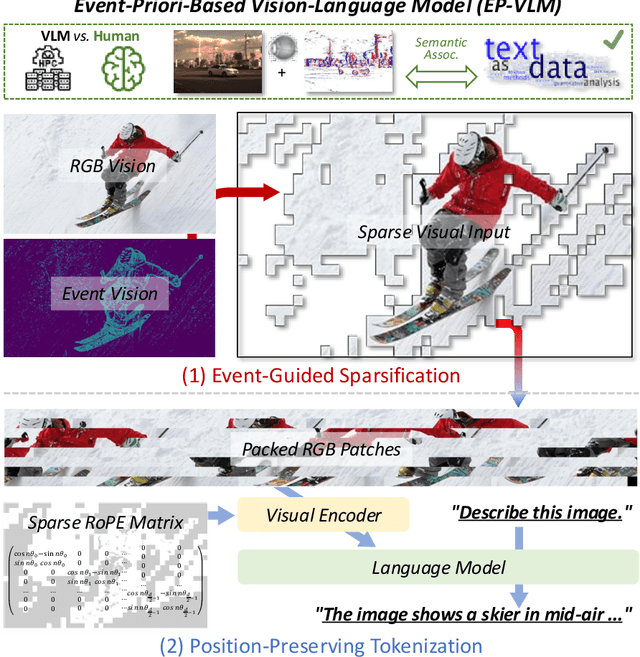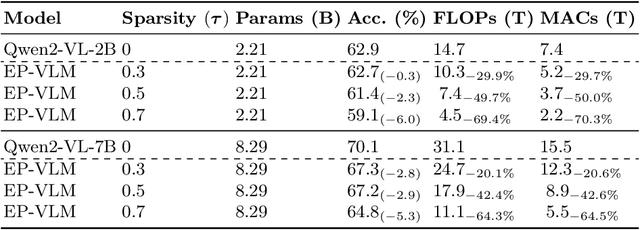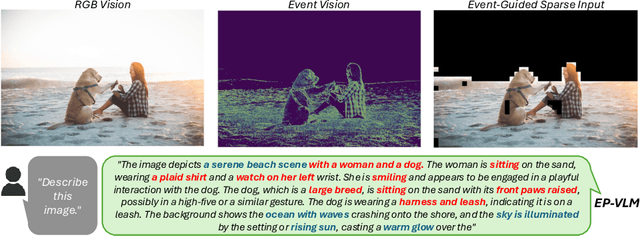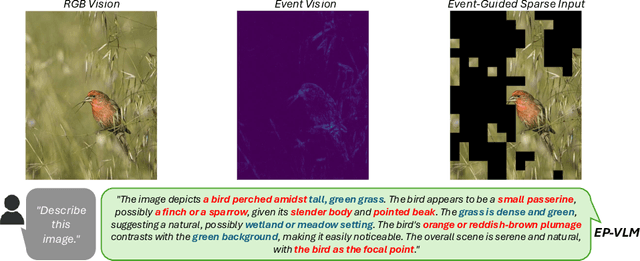Haotong Qin
Exploring Semantic-constrained Adversarial Example with Instruction Uncertainty Reduction
Oct 27, 2025Abstract:Recently, semantically constrained adversarial examples (SemanticAE), which are directly generated from natural language instructions, have become a promising avenue for future research due to their flexible attacking forms. To generate SemanticAEs, current methods fall short of satisfactory attacking ability as the key underlying factors of semantic uncertainty in human instructions, such as referring diversity, descriptive incompleteness, and boundary ambiguity, have not been fully investigated. To tackle the issues, this paper develops a multi-dimensional instruction uncertainty reduction (InSUR) framework to generate more satisfactory SemanticAE, i.e., transferable, adaptive, and effective. Specifically, in the dimension of the sampling method, we propose the residual-driven attacking direction stabilization to alleviate the unstable adversarial optimization caused by the diversity of language references. By coarsely predicting the language-guided sampling process, the optimization process will be stabilized by the designed ResAdv-DDIM sampler, therefore releasing the transferable and robust adversarial capability of multi-step diffusion models. In task modeling, we propose the context-encoded attacking scenario constraint to supplement the missing knowledge from incomplete human instructions. Guidance masking and renderer integration are proposed to regulate the constraints of 2D/3D SemanticAE, activating stronger scenario-adapted attacks. Moreover, in the dimension of generator evaluation, we propose the semantic-abstracted attacking evaluation enhancement by clarifying the evaluation boundary, facilitating the development of more effective SemanticAE generators. Extensive experiments demonstrate the superiority of the transfer attack performance of InSUR. Moreover, we realize the reference-free generation of semantically constrained 3D adversarial examples for the first time.
FlashEdit: Decoupling Speed, Structure, and Semantics for Precise Image Editing
Sep 26, 2025Abstract:Text-guided image editing with diffusion models has achieved remarkable quality but suffers from prohibitive latency, hindering real-world applications. We introduce FlashEdit, a novel framework designed to enable high-fidelity, real-time image editing. Its efficiency stems from three key innovations: (1) a One-Step Inversion-and-Editing (OSIE) pipeline that bypasses costly iterative processes; (2) a Background Shield (BG-Shield) technique that guarantees background preservation by selectively modifying features only within the edit region; and (3) a Sparsified Spatial Cross-Attention (SSCA) mechanism that ensures precise, localized edits by suppressing semantic leakage to the background. Extensive experiments demonstrate that FlashEdit maintains superior background consistency and structural integrity, while performing edits in under 0.2 seconds, which is an over 150$\times$ speedup compared to prior multi-step methods. Our code will be made publicly available at https://github.com/JunyiWuCode/FlashEdit.
$\text{S}^2$Q-VDiT: Accurate Quantized Video Diffusion Transformer with Salient Data and Sparse Token Distillation
Aug 06, 2025Abstract:Diffusion transformers have emerged as the mainstream paradigm for video generation models. However, the use of up to billions of parameters incurs significant computational costs. Quantization offers a promising solution by reducing memory usage and accelerating inference. Nonetheless, we observe that the joint modeling of spatial and temporal information in video diffusion models (V-DMs) leads to extremely long token sequences, which introduces high calibration variance and learning challenges. To address these issues, we propose \textbf{$\text{S}^2$Q-VDiT}, a post-training quantization framework for V-DMs that leverages \textbf{S}alient data and \textbf{S}parse token distillation. During the calibration phase, we identify that quantization performance is highly sensitive to the choice of calibration data. To mitigate this, we introduce \textit{Hessian-aware Salient Data Selection}, which constructs high-quality calibration datasets by considering both diffusion and quantization characteristics unique to V-DMs. To tackle the learning challenges, we further analyze the sparse attention patterns inherent in V-DMs. Based on this observation, we propose \textit{Attention-guided Sparse Token Distillation}, which exploits token-wise attention distributions to emphasize tokens that are more influential to the model's output. Under W4A6 quantization, $\text{S}^2$Q-VDiT achieves lossless performance while delivering $3.9\times$ model compression and $1.3\times$ inference acceleration. Code will be available at \href{https://github.com/wlfeng0509/s2q-vdit}{https://github.com/wlfeng0509/s2q-vdit}.
Pay Less Attention to Deceptive Artifacts: Robust Detection of Compressed Deepfakes on Online Social Networks
Jun 25, 2025Abstract:With the rapid advancement of deep learning, particularly through generative adversarial networks (GANs) and diffusion models (DMs), AI-generated images, or ``deepfakes", have become nearly indistinguishable from real ones. These images are widely shared across Online Social Networks (OSNs), raising concerns about their misuse. Existing deepfake detection methods overlook the ``block effects" introduced by compression in OSNs, which obscure deepfake artifacts, and primarily focus on raw images, rarely encountered in real-world scenarios. To address these challenges, we propose PLADA (Pay Less Attention to Deceptive Artifacts), a novel framework designed to tackle the lack of paired data and the ineffective use of compressed images. PLADA consists of two core modules: Block Effect Eraser (B2E), which uses a dual-stage attention mechanism to handle block effects, and Open Data Aggregation (ODA), which processes both paired and unpaired data to improve detection. Extensive experiments across 26 datasets demonstrate that PLADA achieves a remarkable balance in deepfake detection, outperforming SoTA methods in detecting deepfakes on OSNs, even with limited paired data and compression. More importantly, this work introduces the ``block effect" as a critical factor in deepfake detection, providing a robust solution for open-world scenarios. Our code is available at https://github.com/ManyiLee/PLADA.
PicoSAM2: Low-Latency Segmentation In-Sensor for Edge Vision Applications
Jun 24, 2025Abstract:Real-time, on-device segmentation is critical for latency-sensitive and privacy-aware applications like smart glasses and IoT devices. We introduce PicoSAM2, a lightweight (1.3M parameters, 336M MACs) promptable segmentation model optimized for edge and in-sensor execution, including the Sony IMX500. It builds on a depthwise separable U-Net, with knowledge distillation and fixed-point prompt encoding to learn from the Segment Anything Model 2 (SAM2). On COCO and LVIS, it achieves 51.9% and 44.9% mIoU, respectively. The quantized model (1.22MB) runs at 14.3 ms on the IMX500-achieving 86 MACs/cycle, making it the only model meeting both memory and compute constraints for in-sensor deployment. Distillation boosts LVIS performance by +3.5% mIoU and +5.1% mAP. These results demonstrate that efficient, promptable segmentation is feasible directly on-camera, enabling privacy-preserving vision without cloud or host processing.
Pushing the Limits of Safety: A Technical Report on the ATLAS Challenge 2025
Jun 14, 2025Abstract:Multimodal Large Language Models (MLLMs) have enabled transformative advancements across diverse applications but remain susceptible to safety threats, especially jailbreak attacks that induce harmful outputs. To systematically evaluate and improve their safety, we organized the Adversarial Testing & Large-model Alignment Safety Grand Challenge (ATLAS) 2025}. This technical report presents findings from the competition, which involved 86 teams testing MLLM vulnerabilities via adversarial image-text attacks in two phases: white-box and black-box evaluations. The competition results highlight ongoing challenges in securing MLLMs and provide valuable guidance for developing stronger defense mechanisms. The challenge establishes new benchmarks for MLLM safety evaluation and lays groundwork for advancing safer multimodal AI systems. The code and data for this challenge are openly available at https://github.com/NY1024/ATLAS_Challenge_2025.
Post-Training Quantization for Video Matting
Jun 12, 2025Abstract:Video matting is crucial for applications such as film production and virtual reality, yet deploying its computationally intensive models on resource-constrained devices presents challenges. Quantization is a key technique for model compression and acceleration. As an efficient approach, Post-Training Quantization (PTQ) is still in its nascent stages for video matting, facing significant hurdles in maintaining accuracy and temporal coherence. To address these challenges, this paper proposes a novel and general PTQ framework specifically designed for video matting models, marking, to the best of our knowledge, the first systematic attempt in this domain. Our contributions include: (1) A two-stage PTQ strategy that combines block-reconstruction-based optimization for fast, stable initial quantization and local dependency capture, followed by a global calibration of quantization parameters to minimize accuracy loss. (2) A Statistically-Driven Global Affine Calibration (GAC) method that enables the network to compensate for cumulative statistical distortions arising from factors such as neglected BN layer effects, even reducing the error of existing PTQ methods on video matting tasks up to 20%. (3) An Optical Flow Assistance (OFA) component that leverages temporal and semantic priors from frames to guide the PTQ process, enhancing the model's ability to distinguish moving foregrounds in complex scenes and ultimately achieving near full-precision performance even under ultra-low-bit quantization. Comprehensive quantitative and visual results show that our PTQ4VM achieves the state-of-the-art accuracy performance across different bit-widths compared to the existing quantization methods. We highlight that the 4-bit PTQ4VM even achieves performance close to the full-precision counterpart while enjoying 8x FLOP savings.
Q-SAM2: Accurate Quantization for Segment Anything Model 2
Jun 11, 2025Abstract:The Segment Anything Model 2 (SAM2) has gained significant attention as a foundational approach for promptable image and video segmentation. However, its expensive computational and memory consumption poses a severe challenge for its application in resource-constrained scenarios. In this paper, we propose an accurate low-bit quantization method for efficient SAM2, termed Q-SAM2. To address the performance degradation caused by the singularities in weight and activation distributions during quantization, Q-SAM2 introduces two novel technical contributions. We first introduce a linear layer calibration method for low-bit initialization of SAM2, which minimizes the Frobenius norm over a small image batch to reposition weight distributions for improved quantization. We then propose a Quantization-Aware Training (QAT) pipeline that applies clipping to suppress outliers and allows the network to adapt to quantization thresholds during training. Our comprehensive experiments demonstrate that Q-SAM2 allows for highly accurate inference while substantially improving efficiency. Both quantitative and visual results show that our Q-SAM2 surpasses existing state-of-the-art general quantization schemes, especially for ultra-low 2-bit quantization. While designed for quantization-aware training, our proposed calibration technique also proves effective in post-training quantization, achieving up to a 66% mIoU accuracy improvement over non-calibrated models.
Event-Priori-Based Vision-Language Model for Efficient Visual Understanding
Jun 09, 2025



Abstract:Large Language Model (LLM)-based Vision-Language Models (VLMs) have substantially extended the boundaries of visual understanding capabilities. However, their high computational demands hinder deployment on resource-constrained edge devices. A key source of inefficiency stems from the VLM's need to process dense and redundant visual information. Visual inputs contain significant regions irrelevant to text semantics, rendering the associated computations ineffective for inference. This paper introduces a novel Event-Priori-Based Vision-Language Model, termed EP-VLM. Its core contribution is a novel mechanism leveraging motion priors derived from dynamic event vision to enhance VLM efficiency. Inspired by human visual cognition, EP-VLM first employs event data to guide the patch-wise sparsification of RGB visual inputs, progressively concentrating VLM computation on salient regions of the visual input. Subsequently, we construct a position-preserving tokenization strategy for the visual encoder within the VLM architecture. This strategy processes the event-guided, unstructured, sparse visual input while accurately preserving positional understanding within the visual input. Experimental results demonstrate that EP-VLM achieves significant efficiency improvements while maintaining nearly lossless accuracy compared to baseline models from the Qwen2-VL series. For instance, against the original Qwen2-VL-2B, EP-VLM achieves 50% FLOPs savings while retaining 98% of the original accuracy on the RealWorldQA dataset. This work demonstrates the potential of event-based vision priors for improving VLM inference efficiency, paving the way for creating more efficient and deployable VLMs for sustainable visual understanding at the edge.
Q-VDiT: Towards Accurate Quantization and Distillation of Video-Generation Diffusion Transformers
May 28, 2025Abstract:Diffusion transformers (DiT) have demonstrated exceptional performance in video generation. However, their large number of parameters and high computational complexity limit their deployment on edge devices. Quantization can reduce storage requirements and accelerate inference by lowering the bit-width of model parameters. Yet, existing quantization methods for image generation models do not generalize well to video generation tasks. We identify two primary challenges: the loss of information during quantization and the misalignment between optimization objectives and the unique requirements of video generation. To address these challenges, we present Q-VDiT, a quantization framework specifically designed for video DiT models. From the quantization perspective, we propose the Token-aware Quantization Estimator (TQE), which compensates for quantization errors in both the token and feature dimensions. From the optimization perspective, we introduce Temporal Maintenance Distillation (TMD), which preserves the spatiotemporal correlations between frames and enables the optimization of each frame with respect to the overall video context. Our W3A6 Q-VDiT achieves a scene consistency of 23.40, setting a new benchmark and outperforming current state-of-the-art quantization methods by 1.9$\times$. Code will be available at https://github.com/cantbebetter2/Q-VDiT.
 Add to Chrome
Add to Chrome Add to Firefox
Add to Firefox Add to Edge
Add to Edge